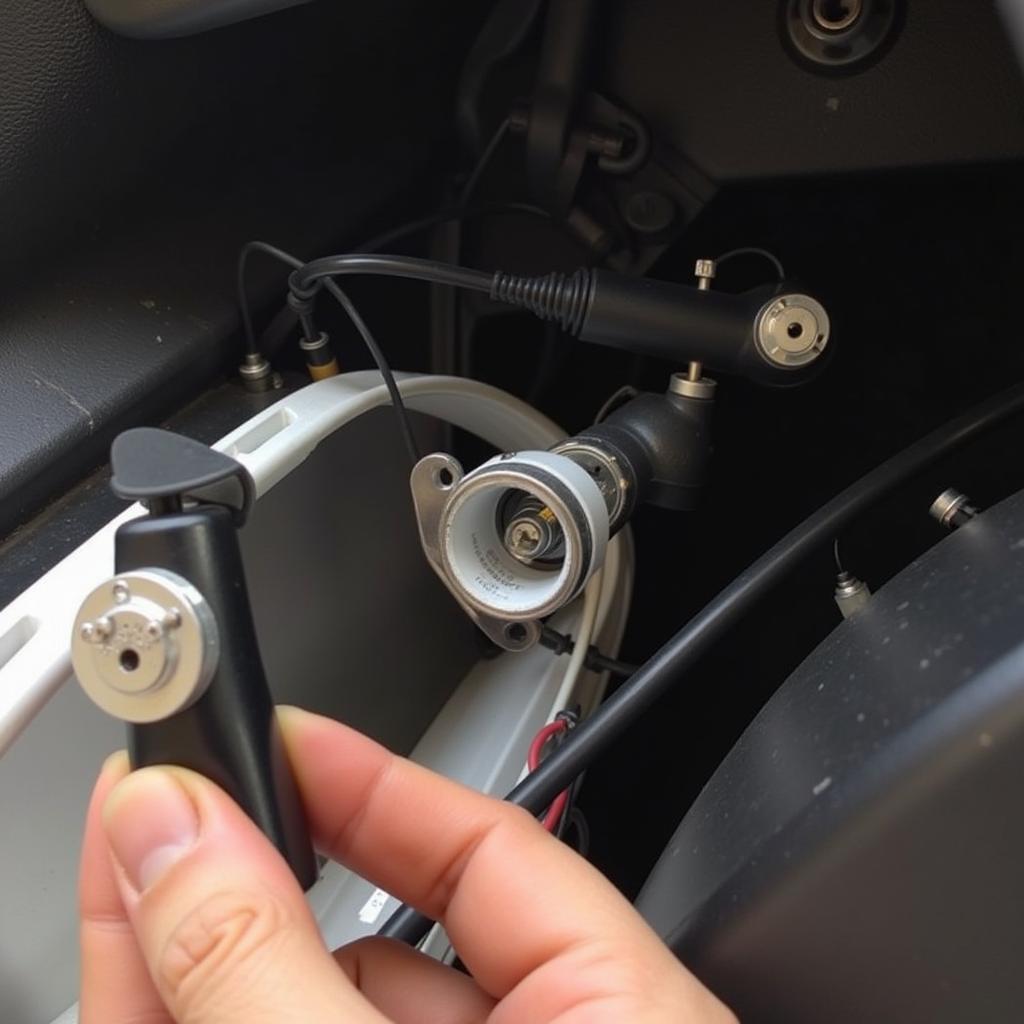A glowing low brake fluid warning light on your dashboard is never a welcome sight. It signifies a potential problem with your car’s braking system, a system you rely on heavily for safety. While a cause for concern, it’s not necessarily a reason to panic. This article explores the common causes of a low brake fluid warning light, how to troubleshoot the issue, and when professional help is needed.
Understanding Your Brake Fluid System
Your car’s braking system relies on hydraulic pressure to function correctly. When you press the brake pedal, you’re essentially pushing brake fluid through lines to activate the calipers or wheel cylinders, which then press the brake pads against the rotors or drums, stopping the vehicle.
Brake fluid is the lifeblood of this system, and a low level can significantly compromise your ability to brake effectively.
Common Causes of a Low Brake Fluid Warning Light
1. Worn Brake Pads
The most common cause of a low brake fluid warning light is worn brake pads. As your brake pads wear down, the brake calipers need to extend further to engage the rotors. This extension requires more brake fluid, leading to a drop in the fluid level in the reservoir.
2. Brake Fluid Leak
A leak in the brake system is another common culprit. Brake fluid can leak from various components, including:
- Brake hoses: These flexible hoses connect the brake lines to the wheels and are prone to wear and tear.
- Brake lines: Corrosion or damage can cause leaks in the metal brake lines.
- Brake calipers: Worn seals or damaged pistons within the calipers can lead to fluid leaks.
- Master cylinder: The master cylinder is responsible for pressurizing the brake system, and a leak here can be serious.
3. Internal Leak in the Master Cylinder
While less common, an internal leak within the master cylinder can also trigger the low brake fluid warning light. This type of leak allows brake fluid to bypass internal seals, reducing the fluid available for braking and potentially damaging the master cylinder.
Troubleshooting a Low Brake Fluid Warning Light
Before assuming the worst, here are a few steps you can take to troubleshoot the issue:
1. Check the Brake Fluid Level
- Locate the brake fluid reservoir: This is usually a translucent plastic container located near the firewall on the driver’s side.
- Check the fluid level: Most reservoirs have “Min” and “Max” markings. If the fluid level is below the “Min” mark, it’s too low.
2. Inspect for Leaks
- Look for signs of leakage: Inspect the area around the brake fluid reservoir, brake lines, hoses, and calipers for any signs of wetness or fluid drips. Brake fluid is typically clear to light brown and has a slightly oily texture.
- Check your garage floor: Look for any fluid spots where you regularly park your car.
3. Check Your Brake Pads
- Inspect your brake pads: If you’re comfortable with basic car maintenance, you can visually inspect your brake pads. Look for worn-down pads that need replacing. If you’re unsure, consult a mechanic.
“Regular brake inspections are crucial for catching potential issues early on,” says John Smith, Senior Automotive Technician at XYZ Auto Repair. “Don’t wait for the warning light to illuminate before checking your brakes.”
When to Call a Mechanic
If you discover a leak, have excessively worn brake pads, or are uncomfortable performing these checks yourself, it’s crucial to consult a qualified mechanic immediately.
Here are some situations where you should seek professional help:
- You notice a significant drop in brake fluid level.
- You see evidence of a brake fluid leak.
- Your brake pedal feels spongy or goes closer to the floor than usual.
- You hear unusual noises when braking, such as grinding or squealing.
- Your car pulls to one side when braking.
- Your ABS (Anti-lock Braking System) warning light is also illuminated.
Importance of Timely Repair
Ignoring a low brake fluid warning light can lead to dangerous consequences. Driving with low brake fluid significantly reduces your braking power, increasing the risk of an accident. Moreover, driving with a leak can cause further damage to your braking system, leading to more costly repairs down the road.
Remote Diagnostics and Repair: A Modern Solution
In today’s technologically advanced world, remote diagnostics and software solutions are playing an increasingly vital role in automotive repair. These advancements allow expert technicians to diagnose and, in some cases, even repair certain car issues remotely, providing a convenient and efficient alternative to traditional repair methods.
intermittent low brake fluid warning focus st light can sometimes be diagnosed and addressed through remote software updates or adjustments, saving car owners time and hassle.
However, it’s important to note that remote solutions are not always feasible for all brake-related issues, particularly those involving physical damage or fluid leaks. A trusted mechanic can assess the situation and recommend the most appropriate course of action.
Conclusion
A low brake fluid warning light should never be ignored. It signals a potential problem with your car’s braking system, a system crucial for your safety and the safety of others. By understanding the common causes, taking the necessary precautions, and seeking professional help when needed, you can ensure your braking system remains in optimal condition, providing you with the peace of mind you deserve on the road.

